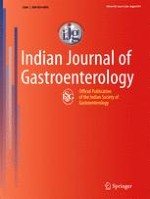Erschienen in:

28.07.2017 | Original Article
The role of preoperative C-reactive protein and procalcitonin as predictors of post-pancreaticoduodenectomy infective complications: A prospective observational study
verfasst von:
Verushka Mansukhani, Gunjan Desai, Rajiv Shah, Palepu Jagannath
Erschienen in:
Indian Journal of Gastroenterology
|
Ausgabe 4/2017
Einloggen, um Zugang zu erhalten
Abstract
Introduction
The common causes of morbidity after pancreaticoduodenectomy (PD) are infective complications. Till date, no specific preoperative markers have been identified to determine the probability of developing infective complications. We have studied the factors predicting the occurrence of the infective complication/s in the present study.
Methods
The present prospective observational study included 133 consecutive patients who underwent PD from January 2011 to June 2016 at a specialized hepatopancreaticobiliary surgical oncology unit. The surgeries were done using a standardized technique. Postoperative complications were segregated into two categories—(a) infective (e.g. cholangitis) and (b) non-infective (e.g. delayed gastric emptying). Increased age, preoperative serum albumin levels, preoperative biliary stenting, pre-stenting serum bilirubin levels, duration of common bile duct stenting, preoperative C-reactive protein [CRP], and procalcitonin [PCT] were evaluated.
Results
Overall morbidity rate was 48.8%. Morbidity associated with infective complications was 21.8%. Increased age, preoperative serum albumin levels, and pre-stenting serum bilirubin levels did not increase the rate of the infective complications. The association between preoperative PCT and preoperative CRP with the infective complications was significant with a p-value of <0.01 (6.75E-07) and <0.01 (4.80E-10), respectively. In the multivariate analysis, only the elevated preoperative procalcitonin was a statistically significant predictor of postoperative infective complications.
Conclusion
Preoperative PCT and CRP levels done 48 h before surgery are sensitive, specific, easily available, and cost-effective predictors of infective complications after PD.











